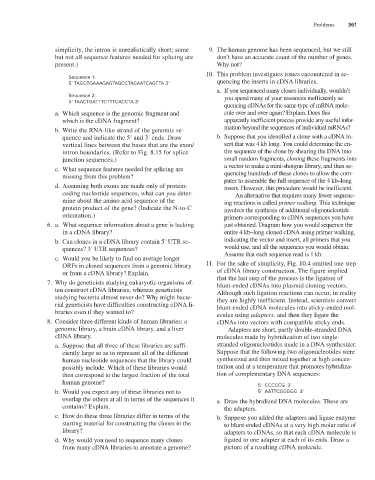Page 67 - Genetics_From_Genes_to_Genomes_6th_FULL_Part3
P. 67
Problems 361
simplicity, the intron is unrealistically short; some 9. The human genome has been sequenced, but we still
but not all sequence features needed for splicing are don’t have an accurate count of the number of genes.
present.) Why not?
10. This problem investigates issues encountered in se-
Sequence 1:
5′ TAGGTGAAAGAGTAGCCTAGAATCAGTTA 3′ quencing the inserts in cDNA libraries.
a. If you sequenced many clones individually, wouldn’t
Sequence 2: you spend many of your resources inefficiently se-
5′ TAACTGATTTCTTTCACCTA 3′
quencing cDNAs for the same type of mRNA mole-
a. Which sequence is the genomic fragment and cule over and over again? Explain. Does this
which is the cDNA fragment? apparently inefficient process provide any useful infor-
b. Write the RNA-like strand of the genomic se- mation beyond the sequences of individual mRNAs?
quence and indicate the 5′ and 3′ ends. Draw b. Suppose that you identified a clone with a cDNA in-
vertical lines between the bases that are the exon/ sert that was 4 kb long. You could determine the en-
intron boundaries. (Refer to Fig. 8.15 for splice tire sequence of the clone by shearing the DNA into
junction sequences.) small random fragments, cloning these fragments into
c. What sequence features needed for splicing are a vector to make a mini-shotgun library, and then se-
missing from this problem? quencing hundreds of these clones to allow the com-
puter to assemble the full sequence of the 4 kb–long
d. Assuming both exons are made only of protein- insert. However, this procedure would be inefficient.
coding nucleotide sequences, what can you deter- An alternative that requires many fewer sequenc-
mine about the amino acid sequence of the ing reactions is called primer walking. This technique
protein product of the gene? (Indicate the N-to-C involves the synthesis of additional oligonucleotide
orientation.) primers corresponding to cDNA sequences you have
6. a. What sequence information about a gene is lacking just obtained. Diagram how you would sequence the
in a cDNA library? entire 4 kb–long cloned cDNA using primer walking,
b. Can clones in a cDNA library contain 5′ UTR se- indicating the vector and insert, all primers that you
quences? 3′ UTR sequences? would use, and all the sequences you would obtain.
c. Would you be likely to find on average longer Assume that each sequence read is 1 kb.
ORFs in cloned sequences from a genomic library 11. For the sake of simplicity, Fig. 10.4 omitted one step
or from a cDNA library? Explain. of cDNA library construction. The figure implied
7. Why do geneticists studying eukaryotic organisms of- that the last step of the process is the ligation of
blunt-ended cDNAs into plasmid cloning vectors.
ten construct cDNA libraries, whereas geneticists Although such ligation reactions can occur, in reality
studying bacteria almost never do? Why might bacte- they are highly inefficient. Instead, scientists convert
rial geneticists have difficulties constructing cDNA li- blunt-ended cDNA molecules into sticky-ended mol-
braries even if they wanted to? ecules using adapters, and then they ligate the
8. Consider three different kinds of human libraries: a cDNAs into vectors with compatible sticky ends.
genomic library, a brain cDNA library, and a liver Adapters are short, partly double-stranded DNA
cDNA library. molecules made by hybridization of two single-
a. Suppose that all three of these libraries are suffi- stranded oligonucleotides made in a DNA synthesizer.
ciently large so as to represent all of the different Suppose that the following two oligonucleotides were
human nucleotide sequences that the library could synthesized and then mixed together at high concen-
possibly include. Which of these libraries would tration and at a temperature that promotes hybridiza-
then correspond to the largest fraction of the total tion of complementary DNA sequences:
human genome? 5′ CCCCCG 3′
b. Would you expect any of these libraries not to 5′ AATTCGGGGG 3′
overlap the others at all in terms of the sequences it a. Draw the hybridized DNA molecules. These are
contains? Explain. the adapters.
c. How do these three libraries differ in terms of the b. Suppose you added the adapters and ligase enzyme
starting material for constructing the clones in the to blunt-ended cDNAs at a very high molar ratio of
library? adapters to cDNAs, so that each cDNA molecule is
d. Why would you need to sequence many clones ligated to one adapter at each of its ends. Draw a
from many cDNA libraries to annotate a genome? picture of a resulting cDNA molecule.

